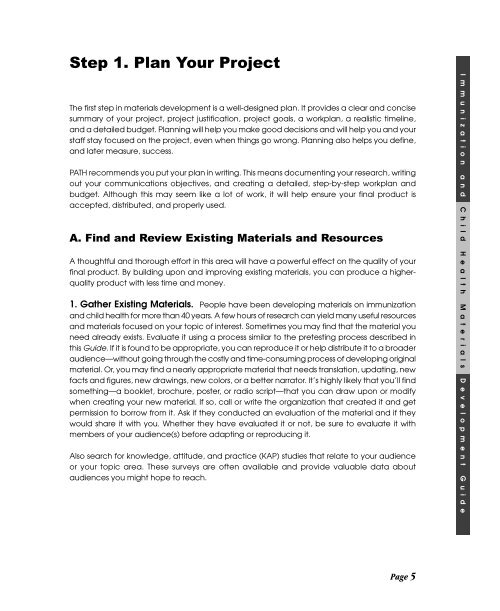Immunization and child health materials development guide pdf
Immunization and child health materials development guide pdf
Immunization and child health materials development guide pdf
You also want an ePaper? Increase the reach of your titles
YUMPU automatically turns print PDFs into web optimized ePapers that Google loves.
Step 1. Plan Your Project<br />
The first step in <strong>materials</strong> <strong>development</strong> is a well-designed plan. It provides a clear <strong>and</strong> concise<br />
summary of your project, project justification, project goals, a workplan, a realistic timeline,<br />
<strong>and</strong> a detailed budget. Planning will help you make good decisions <strong>and</strong> will help you <strong>and</strong> your<br />
staff stay focused on the project, even when things go wrong. Planning also helps you define,<br />
<strong>and</strong> later measure, success.<br />
PATH recommends you put your plan in writing. This means documenting your research, writing<br />
out your communications objectives, <strong>and</strong> creating a detailed, step-by-step workplan <strong>and</strong><br />
budget. Although this may seem like a lot of work, it will help ensure your final product is<br />
accepted, distributed, <strong>and</strong> properly used.<br />
A. Find <strong>and</strong> Review Existing Materials <strong>and</strong> Resources<br />
A thoughtful <strong>and</strong> thorough effort in this area will have a powerful effect on the quality of your<br />
final product. By building upon <strong>and</strong> improving existing <strong>materials</strong>, you can produce a higherquality<br />
product with less time <strong>and</strong> money.<br />
1. Gather Existing Materials. People have been developing <strong>materials</strong> on immunization<br />
<strong>and</strong> <strong>child</strong> <strong>health</strong> for more than 40 years. A few hours of research can yield many useful resources<br />
<strong>and</strong> <strong>materials</strong> focused on your topic of interest. Sometimes you may find that the material you<br />
need already exists. Evaluate it using a process similar to the pretesting process described in<br />
this Guide. If it is found to be appropriate, you can reproduce it or help distribute it to a broader<br />
audience—without going through the costly <strong>and</strong> time-consuming process of developing original<br />
material. Or, you may find a nearly appropriate material that needs translation, updating, new<br />
facts <strong>and</strong> figures, new drawings, new colors, or a better narrator. It’s highly likely that you’ll find<br />
something—a booklet, brochure, poster, or radio script—that you can draw upon or modify<br />
when creating your new material. If so, call or write the organization that created it <strong>and</strong> get<br />
permission to borrow from it. Ask if they conducted an evaluation of the material <strong>and</strong> if they<br />
would share it with you. Whether they have evaluated it or not, be sure to evaluate it with<br />
members of your audience(s) before adapting or reproducing it.<br />
Also search for knowledge, attitude, <strong>and</strong> practice (KAP) studies that relate to your audience<br />
or your topic area. These surveys are often available <strong>and</strong> provide valuable data about<br />
audiences you might hope to reach.<br />
Page 5

















